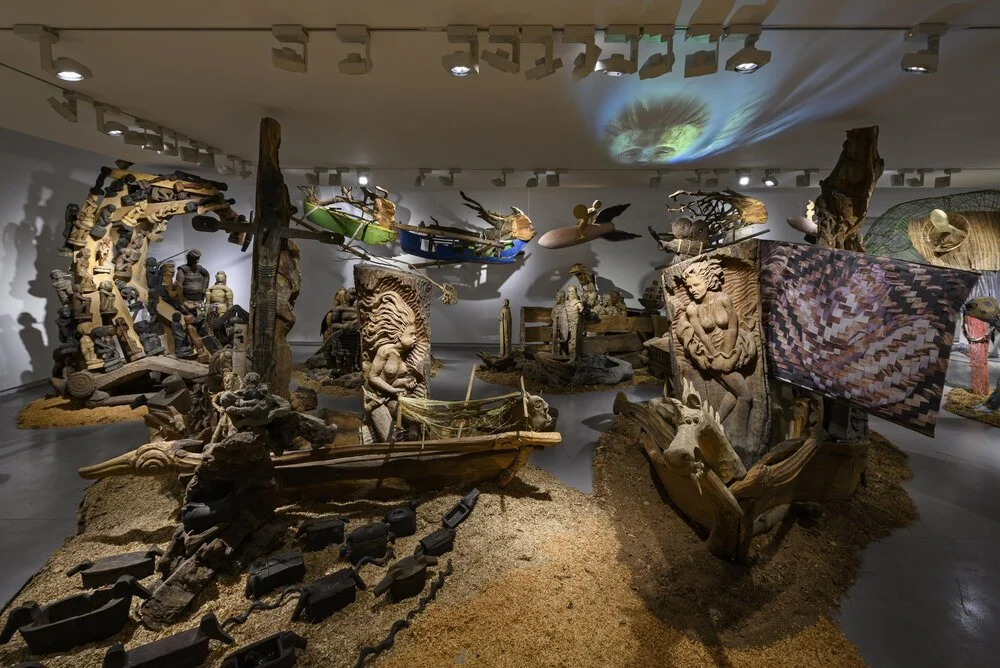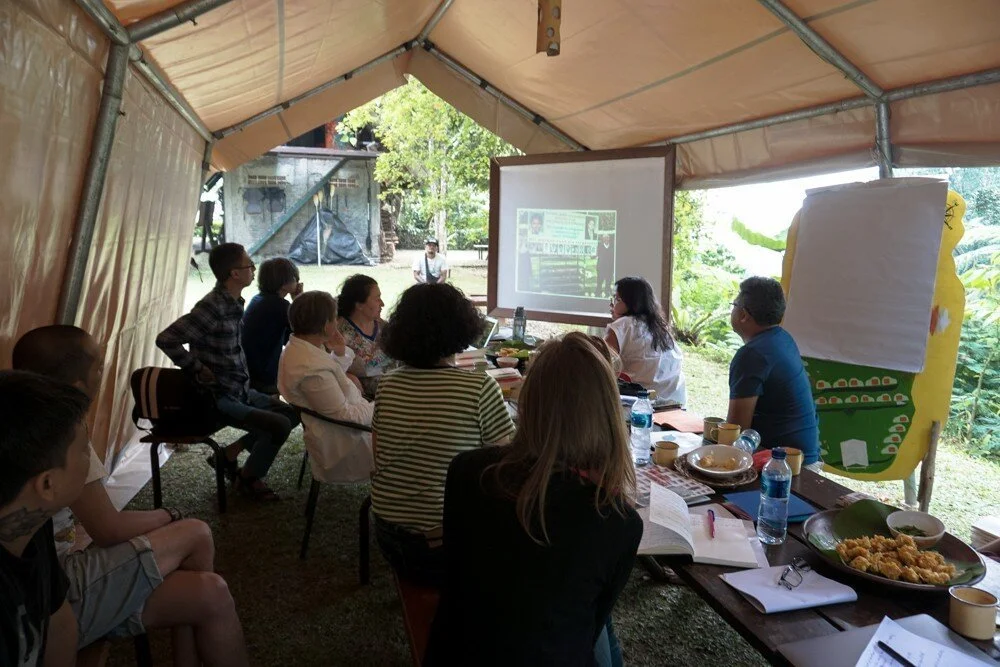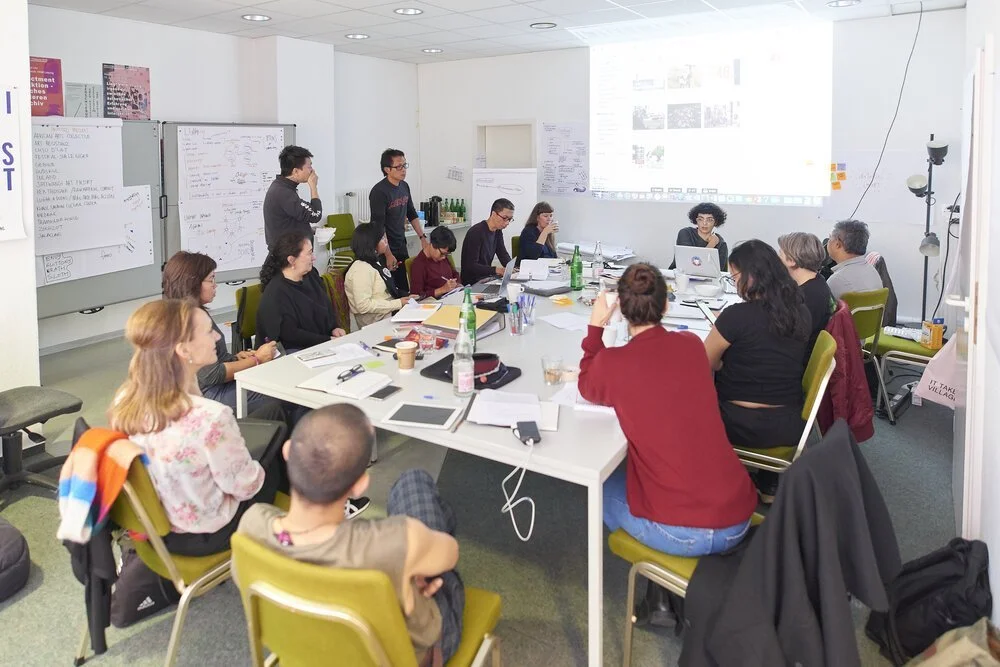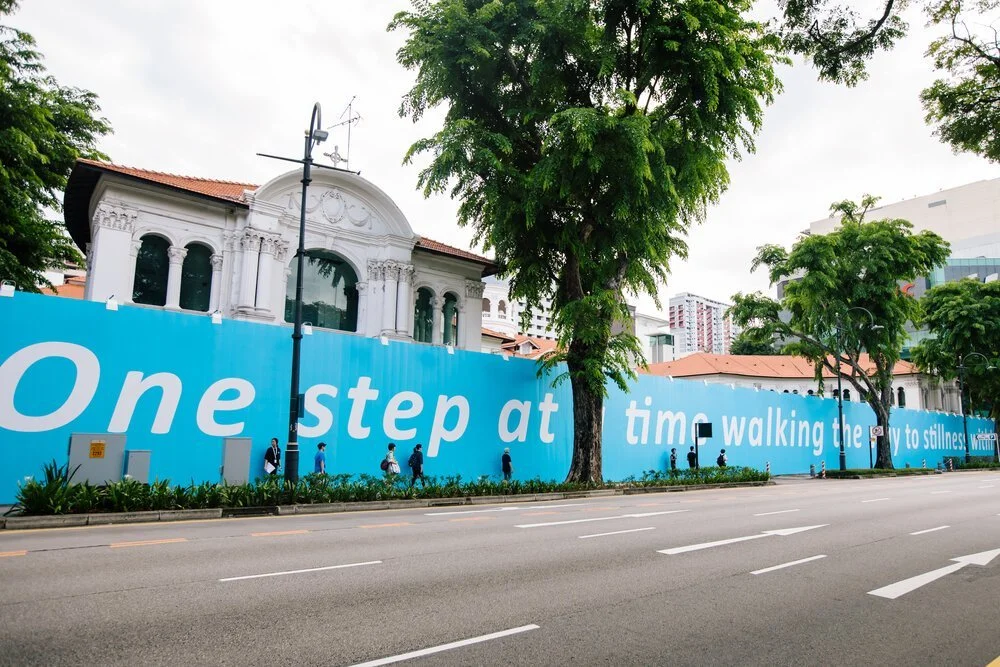How Can Art Biennials Continue to be Relevant?
Southeast Asian instigators offer their opinions
Kidlat Tahimik, Ang Ma-bagyong Sabungan ng 2 Bathala ng Hangin, A Stormy Clash Between 2 Goddesses of the Winds (WW III – the Protracted Kultur War), 2019, wooden carved icons, ritual objects, interwoven C-print photographs, projected images, audio, mosaic, rattan-basket figurines, back-strap bamboo loom, wrought-iron launch-pads, fibreglass, root sculptures, rotten fishing boats, sawdust, bamboo fences and runo-reed fauna, dimensions variable. Installation view, Journey Beyond the Arrow - Leaving the Echo Chamber: Sharjah Biennial 14 (2019). Commissioned by Sharjah Art Foundation. Image courtesy of the Sharjah Art Foundation.
Biennials are grand affairs in the art world. Mainstays in the art circuit, they tend to be both a source of national pride and a form of cultural currency for their organisers and participants. This format of exhibition-making, where a mega exhibition takes place once every two to three years with a usually international artist line-up, first gained prominence in Europe with the founding of the Venice Biennale in 1895. Since then, there has been a steady increase in the number of biennials occurring worldwide, so much so that this phenomenon has been termed the “biennial boom”.
This boom is not homogenous around the globe. While it occurred in Europe around the 1980s, the biennial format only gained popularity in Asia and other continents in the late 1990s. This has been attributed to the end of the Cold War, as well as the rise in the popularity of postcolonial studies. Both factors laid the groundwork for a contemporary art world that espoused pluralistic, non-eurocentric narratives as the world moved away from the polarised politics of the Cold War. As for Southeast Asia, the trend of biennalisation was more recent and only started gaining momentum from the 2000s. As examples, the Singapore Biennale, Biennale Jogja, Bangkok Art Biennale and the Kuala Lumpur Biennial all came into being in the last two decades.
“One major argument against the biennial model in current discourse is how it tries to encompass too much at one go in a paradoxical manner, where its conceptual premise has to be contemporary yet have a sense of timelessness, and is focused on its local context while being global in its offerings. ”
To date, there are over 300 biennials in the world, making for an overflowing international art calendar that had no signs of slowing down before the COVID-19 pandemic. This development is not without its critics. One major argument against the biennial model in current discourse is how it tries to encompass too much at one go in a paradoxical manner, where its conceptual premise has to be contemporary yet have a sense of timelessness, and is focused on its local context while being global in its offerings.
And because of its short-lived nature relative to its size, with most running for approximately three to five months, biennials tend toward the spectacular in order to attract an audience. This is often done at the expense of artists, curators and cultural workers who are pressed to produce at a pressured pace. The intensity is felt even more keenly when having to juggle multiple projects at once, especially for freelance artists and curators. Finally, owing to the significant amount of resources required to put up a biennial, these shows are usually directly or indirectly funded by the state, making it a major stakeholder when it comes to the output of the exhibition. As a result, political agendas and barriers might take precedence over artistic and curatorial intent, such as statecraft, tourism and censorship.
ruangrupa Artistic Team assembly in Tanakita, 2019. Photo by Jin Panji.
ruangrupa Artistic Team assembly in Kassel, 2019. Photo by Nicolas Wefers.
At the same time, it is unfeasible to think about an art world without biennials. In spite of the growing discontent, they are undeniably integral structures in the international art circuit. A significant component of taking part in a biennial is the resources afforded to participants. Multi-hatted cultural practitioner Farid Rakun, who currently serves as a researcher and education coordinator for the Indonesian artists' initiative ruangrupa, says, “Biennials have a kind of sustainability in an infrastructural sense, from the space to the funding and the ability to have recurring editions.” ruangrupa members are also the co-organisers of the Jakarta Biennale, from 2009-2017, and the Artistic Directors of the upcoming documenta fifteen in Kassel. This is particularly important for commissioned artists who can make use of the platform to produce on a scale that was previously unattempted in their practice.
And it is especially poignant for those whose own local art ecosystem is still in its infancy. Zoe Butt, Artistic Director of The Factory Contemporary Arts Centre in Ho Chi Minh City, says of the Sharjah Biennial 14 which she co-curated, “It has significant capacity and willingness to support the emerging. By that, I mean that it has the funds and expertise to enable little-exposed narratives and what’s more, they have an incredible international network with which to engage and broaden the perspectives of participating artists.” Indeed, biennials create a space for the facilitation of such international exchanges that would otherwise be hard to come by.
“In spite of the growing discontent, they are undeniably integral structures in the international art circuit. A significant component of taking part in a biennial is the resources afforded to participants.”
Amanda Heng, Every Step Counts, 2019 (along Bras Basah road). Image courtesy of Singapore Art Museum.
Artists and cultural practitioners also work within the biennial system to maximise the potential of their participation. An important aspect of this is the ability to form relationships and circulate the flow of ideas on a larger scale. “The best thing about these big events is that it provides an “in-time” gathering. It gives an excuse for people to gather, and a lot of things happen as a result of that, whether or not it is in line with the event’s objectives,” Rakun says. “There is a trickle-down effect, such as conversations, co-operations and collaborations with different individuals and institutions.” Indeed, such “in-time” gatherings, where people and events gather and occur at the same time, may often provoke unexpected and cherished relationship-making, especially since they bring a number of individuals together who would otherwise be unlikely to meet in other circumstances.
And on the ability to mould the outcome of a biennial, Philippine curator and professor Patrick Flores, who was the Artistic Director of Singapore Biennale 2019 and curator of the Philippine Pavilion at Venice Biennale 2015, says, “Biennales are shaped by curatorial discourse. And curators do not just exemplify this discourse. They perform it as they curate the biennale through gestures that translate to the circulation of materialities, the creation of situations, and the production of hopefully reciprocal discourse.” Thinking through this perspective, it is important to recognise that certain biennials have been tools for representation and resistance, such as how the Asia-Pacific Triennial and Fukuoka Asian Art Triennale have historically validated the work of Southeast Asian artists and Asia-Pacific artists at large.
Nevertheless, artists and cultural practitioners continue to reimagine what a biennial can be, in light of the growing criticisms this exhibitionary model faces. A big part of this comes from the criticality that biennale participants impose upon their own position. Of having to navigate some of the format’s entrappings, such as its aspirations to be homogeneously global, Butt says, “My frustrations toward assumptions of “globality” persist, but not in an unproductive way. Rather, I see the purpose of my work to challenge the assumptions of politics and capital behind cultural consumption.”
Flores concurs, saying, “I am wary of biennales that rely on signatures of artists or art forms. For me, they tend to become franchises of the global inventory. I am more interested in dispersed materialities that propose plural trajectories instead of a monolithic image or a fully formed accomplishment.” He adds, “I think what the pandemic has made us realise is the need for the biennale modality to signify or intuit precarity and vulnerability in the context of a persistent resistance.” Through such self-reflexiveness, biennials become not just a standard model for large-scale, spectacular exhibitions, but also a space for generative thoughts and processes.
ruangrupa, lumbung drawing, 2020. Image courtesy of Iswanto Hartono.
A fairly recent example of how such penetrative contemplations are translated into a functioning framework is ruangrupa’s documenta 15. Using lumbung, or “rice barn”, as a model, the curatorial practice centres on principles of collectivity, resource building and equal sharing. Other collectives are invited to collaborate as lumbung members, so as to collectively imagine and work toward a more sustainable cultural and social sphere. Rakun explains, “We want to prove that another type of documenta could happen, a documenta that actually plays a vital role for people who have not been touched by contemporary art.” He elaborates, “We want to expand the space, as well as the time, to go beyond the explosion of events that lasts for short periods. In this way, the agency of such mega-events can be much more real, and not extractive.”
It becomes evident that ruangrupa is maximising their position in documenta 15 to propose for a more thoughtful and sustainable biennial methodology through the selected lumbung members, such as FAFSWAG, a Moana Oceanic arts collective committed to social change, and INLAND, a platform for diverse actors engaged in agricultural, social and cultural production. And in spite of COVID-19 travelling restrictions, ruangrupa has made it a point to continually meet up with their collaborators online so as to continually foster the spirit of lumbung.
Rather than adopting a mentality that imposes a hard rejection of the biennial format, it may be more productive to work within the structures to continually progress toward a curatorial and ethical ideal. After all, each new iteration promises a space for change and action by its instigators. At the same time, it is still prudent to be cautious of what a biennial can and cannot offer. It is in this spirit that many members of the art world have organised their own independent and alternative biennials.
Click here to read The Rise of Independent and Alternative Biennials, where we delve deeper into why such exhibitions have been popping up and the issue of their sustainability.





